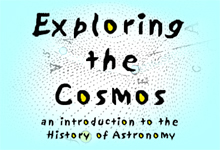

Department of History
University of California, Irvine
Instructor: Dr. Barbara J. Becker
![]()
Lecture 7. The Starry Messenger.
![]()
|
|
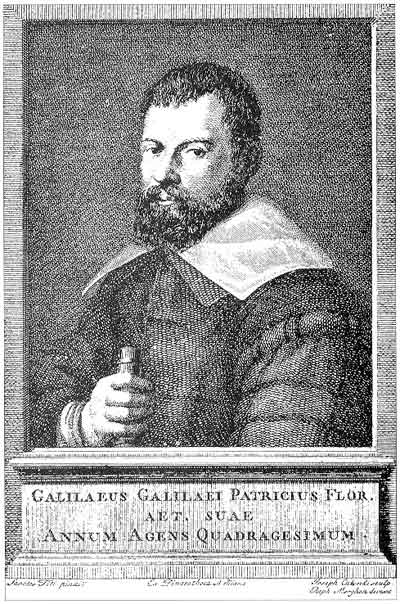
|
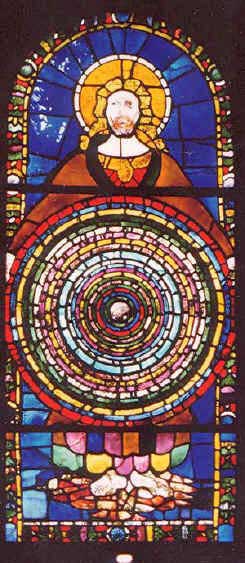
Stained glass window in Pisa's Santa Maria cathedral (1063) showing the Earth encircled by the heavenly spheres.
|
|
1564 |
born at Pisa |
1581 |
enrolled at University of Pisa as medical student |
1585 |
abandoned medicine for mathematics |
1589 |
took teaching post at Pisa |
1590 |
began writing down his thoughts how things move |
1592 |
took position as professor of mathematics at University of Padua
earned money selling gadgets and serving as military consultant |
1605 |
served as mathematics tutor to Cosimo de' Medici |
1609 |
Cosimo became Grand Duke of Tuscany |
1610 |
published Sidereus Nuncius [Starry Messenger]
-resigned post at Padua -took position of "Chief Mathematician and Philosopher" to Grand Duke Cosimo II |
THE STARRY MESSENGER |
|
Revealing great, unusual, and remarkable spectacles, opening these
to the consideration of every man,
AS OBSERVED BY GALILEO GALILEI
WITH THE AID OF A
lately invented by him, In the surface of the Moon, in innumerable Fixed Stars, in Nebulae,
in FOUR PLANETS swiftly revolving about Jupiter at differing distances and periods,
and known to no one before the Author recently perceived them and decided
that they should be named
Venice
To the Most Serene
...scarce have the immortal graces of your spirit begun to shine on earth when in the heavens bright stars appear as tongues to tell and celebrate your exceeding virtues to all time. Behold, then, four stars reserved to bear your famous name; bodies which belong not to the inconspicuous multitude of fixed stars, but to the bright ranks of the planets.... ...Indeed, the Maker of the stars himself has seemed by clear indications to direct that I assign to these new planets Your Highness's famous name.... For just as these stars, like children worthy of their sire, never leave the side of Jupiter ... so clemency, kindness of heart, gentleness of manner, splendor of royal blood, nobility in public affairs, and excellency of authority and rule have all fixed their abode and habitation in Your Highness.... |
New Instruments as Tools of Persuasion |
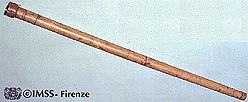
Galileo's Telescope Institute and Museum of the History of Science Florence, Italy
|
Galileo's Telescopic Views of the Fixed Stars |
What was observed by us in the third place is the nature or matter of the Milky Way itself, which, with the aid of the spyglass, may be observed so well that all the disputes that for so many generations have vexed philosophers are destroyed by visible crertainty, and we are liberated from wordy arguments. For the Galaxy is nothing else than a congeries of innumerable stars distributed in clusters. To whatever region of it you direct your spyglass, an immense number of stars immediately offer themselves to view, of which very many appear rather large and very conspicuous but the multitude of small ones is truly unfathomable.... |
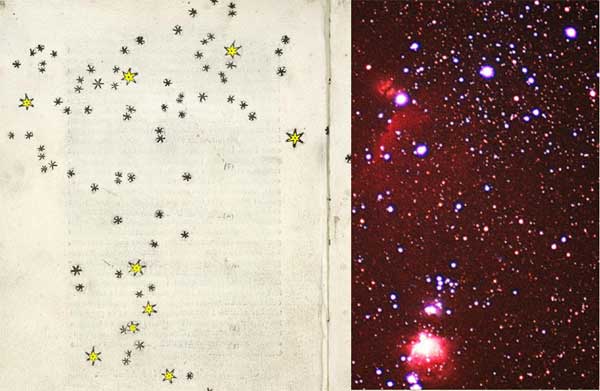
Galileo's sketch of the stars in Orion's belt and sword compared with a modern day photograph of the same region (right).
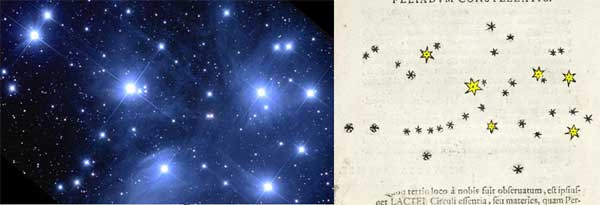
Galileo's sketch of the stars in the Pleiades compared with a modern day photograph of the same region (left).
|
|
as Determined using a Modern Computer Planetarium Program (Redshift) |
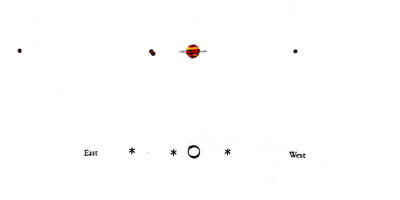 |
January 7, 1610 [T]wo stars were near [Jupiter] on the east and one on the west.... I was not the least concerned with their distances from Jupiter, for ... at first I believed them to be fixed stars.... |
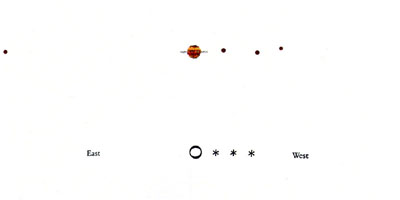 |
[O]n the eighth ... I found a very different arrangement. For all three little stars were to the west of Jupiter and closer to each other than the previous night.... I was aroused by the question of how Jupiter could be to the east of all the said fixed stars when the day before he had been to the west of them.... |
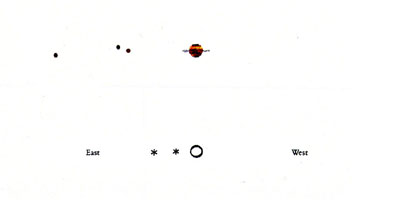 |
[O]n the tenth ... [o]nly two stars were near him, both to the east.... |
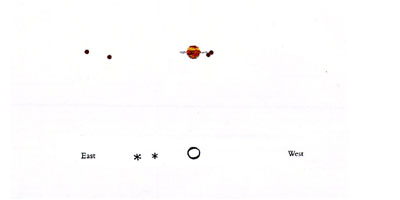 |
There were only two stars on the east, of which the middle one was three times as far from Jupiter than from the more eastern one.... I therefore arrived at the conclusion, entirely beyond doubt, that in the heavens there are three stars wandering around Jupiter like Venus and Mercury around the Sun.... |
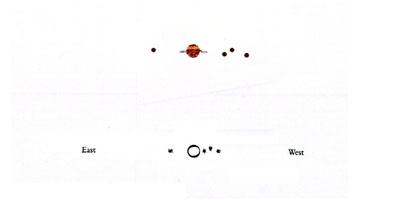 |
[F]or the first time four little stars were seen by me.... They formed a very nearly straight line, but the middle star of the western ones was displaced a little to the north from the straight line.... |
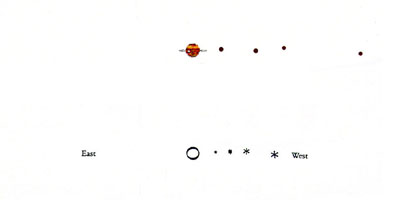 |
[T]he four stars ... were all to the west and arranged very nearly in a straight line, except that the third one from Jupiter was raised a little bit to the north.... They were very brilliant and did not twinkle, as indeed was always the case.... |
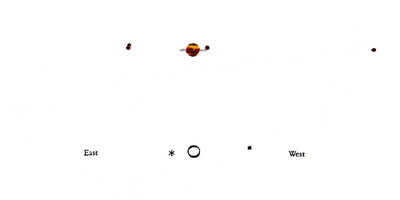 |
On the seventeenth, 30 minutes after sunset, the configuration was thus. There was only one star on the east, 3 minutes from Jupiter. Likewise, one was 11 minutes from Jupiter to the west. The eastern one appeared twice as large as the western one. There were no more than these two.... |
 |
...But after 4 hours ... on the eastern side a third began to emerge, which, I suspect, had earlier been united with the first one.... |
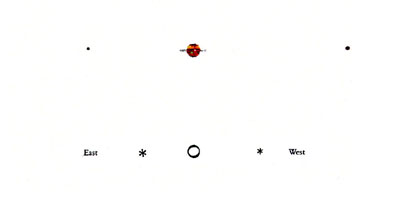 |
On the eighteenth ... [t]he eastern star was larger than the western one and 8 minutes distant from Jupiter, while the western one was 10 minutes from Jupiter. |
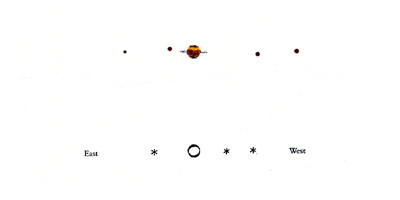 |
There were three stars exactly on a straight line through Jupiter.... At this time I was uncertain whether between the eastern star and Jupiter there was a little star, very close to Jupiter, so that it almost touched him. |
Kepler's Response to Starry Messenger |
|
[Your] assertions about the body of the moon are made by others on the basis of mutually self-supporting evidence. Their conclusions agree with the highly illuminating observations which you report on the same subject. Consequently I have no basis for questioning the rest of your book and the four satellites of Jupiter. I should rather wish that I now had a telescope at hand, with which I might anticipate you in discovering two satellites of Mars (as the relationship seems to me to require) and six or eight satellites of Saturn, with one each perhaps for Venus and Mercury.... --Kepler's comments on Starry Messenger in a letter to Galileo (April 1610) |
New Instruments Change How and What We See |
|
The Moon by William Gilbert, c. 1600 |
|
Sketch of the moon based on naked eye observation, by English observer, Thomas Hariot, July 1609. |
|
Sketch of the moon from Sidereus Nuncius; based on telescopic observation, by Galileo, early 1610. |
|
Sketch of the moon based on telescopic observation after reading Sidereus Nuncius, by Thomas Hariot, July 1610. |
|
The Moon by Carl Scheiner, c. 1614 |
|
|
by Thomas Hariot (c. 1560-1621)
|
|